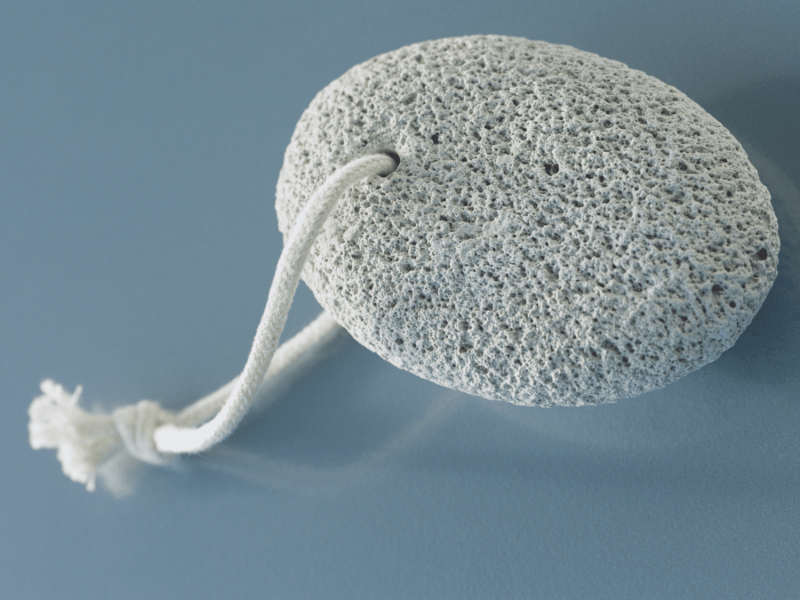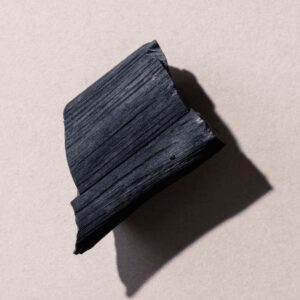
Rinse Your Pumice Stone Use the Pumice Stone to Exfoliate Rinse Off Your Skin Moisturize Your Skin Rinse Off Your Pumice Stone
It’s a fact of life: Feet tend to experience dryness, cracking, and calluses. The culprit is two-fold, as not only do the soles of the feet experience more pressure and friction than most parts of the body, but also, your foot’s skin contains an extra layer of epidermis known as the stratum lucidum. However, just because feet are prone to these conditions doesn’t mean you have to live with them. Exfoliation is the key to achieving a soft, smooth feel. And, if you’re looking for a new addition to your beauty toolkit, you may want to consider a tried-and-true favorite—the pumice stone.
Pumice stones (an abrasive rock formed when lava and water mix) are a simple way to soften dry, rough skin. One of these may be just what you need to give your feet a little TLC. For tips on how best to use a pumice stone, we tapped top dermatologists Hadley King, MD, and Dustin Portela, MD.
Keep reading for everything you need to know about pumice stones.
What Are Pumice Stones?
A pumice stone is a type of lightweight, highly porous, and abrasive rock that forms when lava and water mix. “It’s often used as a personal care product for its natural exfoliating properties, to remove dead skin cells and callouses from the feet,” Portela says. Pumice stones can be more abrasive than other exfoliation methods, so if you’re going to use one to exfoliate your skin, it’s best to avoid your face and stick to areas of the hands and feet that have calluses. “Don’t use a pumice stone over areas that don’t have a callus buildup,” Portela tells us. “I strongly discourage using a pumice stone on the face.”
For softer and more sensitive areas of skin like elbows and knees, King suggests using a product formulated with pumice particles rather than a pumice stone. Schaf Skincare's Facial Scrub is a great option for those more sensitive areas," she says, explaining that this type of product polishes away dead skin cells while also boosting hydration.
Benefits of Using Pumice Stones
If you decide to use a pumice stone on your feet, hands, or another callused area, you'll discover there are a few main benefits:
- Smooths and softens skin: "The gentle exfoliation of a pumice stone will leave your skin smoother and softer," Portela says. "This allows your moisturizer and any other skin products to work better."
- Increases radiance: You may notice improved complexion, too. "Regular exfoliation with a pumice stone helps to brighten the complexion by removing old, dead skin cells and revealing the fresh new skin cells that hide underneath," King says.
- Improves overall comfort: Beyond just looks, another perk of using a pumice stone to exfoliate is that you may notice your hands and feet feel better. "Removing thick calluses can also reduce pain while walking," Portela tells us.
Risks of Using Pumice Stones
One risk when using a pumice stone is that it could irritate your skin. If you use too much pressure, this may increase the risk of pain, skin irritation, inflammation, and infection. “To avoid this, look for products with very fine particles and use gentle pressure,” King says. If your skin is sensitive and prone to irritation, King recommends avoiding pumice stones and sticking to chemical exfoliation.
It can also be risky to use a pumice stone if you have neuropathy from diabetes or another cause. Neuropathy can cause numbness and loss of sensation, so using a pumice stone in those areas is generally not recommended. "You may not feel pain if you begin to over-exfoliate, increasing your risk of infection," Portela explains.
How to Use a Pumice Stone
Pre-Soak Your Hands and Feet
Pumice stones are most often used on feet and/or hands. To begin, soak whatever area you plan to exfoliate in warm water for five to 15 minutes. King tells us you'll know you've soaked enough when your skin is soft and wet but hasn't become wrinkled from being in the water for too long.
Rinse Your Pumice Stone
Before exfoliating your hands or feet, thoroughly wet the pumice stone, as using the tool dry isn't recommended. Portela adds that as you exfoliate, you may want to occasionally rinse the stone again to remove the buildup of dead skin.
Use the Pumice Stone to Exfoliate
Using light or moderate pressure, move the pumice stone in a circular motion over callused areas of the skin on your feet or hands. Light pressure is generally best, but you can use more pressure if the area isn't sensitive and you're not feeling any pain. King says that one or two minutes of exfoliating is all it takes to remove dead skin. If you feel pain or sensitivity along the way, you should stop using the pumice stone.
Rinse Off Your Skin
After you've used the pumice stone to exfoliate, you may have some loose dead skin left over on your hands and feet. Simply rinse the area with water to remove this, and enjoy the satisfying reveal of the smooth skin underneath.
Moisturize Your Skin
For the final step, you’ll want to moisturize, just as you would after exfoliating the skin on your face or body. King suggests using a quality product (like these Byrdie-approved foot creams) that will hydrate, support your skin barrier, and lock in moisture.
Rinse Off Your Pumice Stone
Before putting away your pumice stone, rinse it with water and a bit of soap to remove any dead skin. You could also boil the stone in hot water. Afterward, leave the pumice stone to dry in a clean, dry area that isn't high in moisture. Also, keep in mind that it's not a good idea to share your pumice stones, as this can spread bacteria and fungus.
The Final Takeaway
Pumice stones are a popular option for exfoliating callused areas of skin like your hands and feet. To avoid irritation, pain, and other negative side effects when using a pumice stone, it's important to apply only light to moderate pressure. The dermatologists we spoke with agree that pumice stones should not be used on your face. As long as you're gentle and follow the instructions properly, this exfoliation method is likely to leave your feet and hands with the smooth, rejuvenated feel you want for summer (or any time of year).
Article Sources Byrdie takes every opportunity to use high-quality sources, including peer-reviewed studies, to support the facts within our articles. Read our editorial guidelines to learn more about how we keep our content accurate, reliable and trustworthy.
-
Peripheral neuropathy: what it is, symptoms & treatment. Cleveland Clinic.

